Table of Contents
Points Miles and Bling (blog) contains referral or affiliate links. The blog receives a small commission at no additional cost to you. Thank you for your continued support. Credit Card issuers are not responsible for maintaining or monitoring the accuracy of information on this website. For full details, current product information, and Terms and Conditions, click the link included.
Introduction
After a comfortable flight on QSuite from Montreal to Doha, we made the short hop to arrive at Queen Alia International Airport (AMM) in Amman.
Bustling with energy and life, Amman is the largest city in the Kingdom of Jordan and is its capital. It also happens to be the largest Levantine city in the region. Today, Levant refers to the countries located in the Eastern Mediterranean region in Western Asia, also known as “Bilad El-Sham” in Arabic.
Similar to Rome, Amman was initially built on seven hills. Fast forward to today; the capital spans 19 hills with three primary ravines. While Amman isn’t as glitzy as some of the cities in the Gulf region, it is a modern city with a rich history.

Amman, Jordan
Best Time to Visit Amman, Jordan
Amman experiences all four seasons, where it occasionally snows in the winter. The summers are usually long, and it does get hot! Yet, it doesn’t reach the levels of scorching heat that you’ll experience in the Gulf.
It’s a dry climate, and there’s usually a cool breeze in the evenings/nights, making it perfect for outings and staying up late in the summer! During this season, there are numerous events, festivals and concerts. Expect large crowds!
Not only does Amman get a lot of tourists during the summer, but many Jordanian citizens who work in the Gulf countries will come to Amman to visit their families. Expect a lot of traffic when on the road.
The best time to visit is spring (late March to May). It’s still busy but with fewer crowds. You can enjoy moderately warm temperatures unless a heatwave makes an appearance!
How to Get Around in Amman, Jordan
For maximum freedom, renting a car is the best option. There are eight traffic roundabouts (called Circles), so learning their numbers will help you get better-oriented. Most locals drive manual there because of all the hills.
Driving in Amman can be a bit chaotic. Who knows, you might even see a camel like I did!
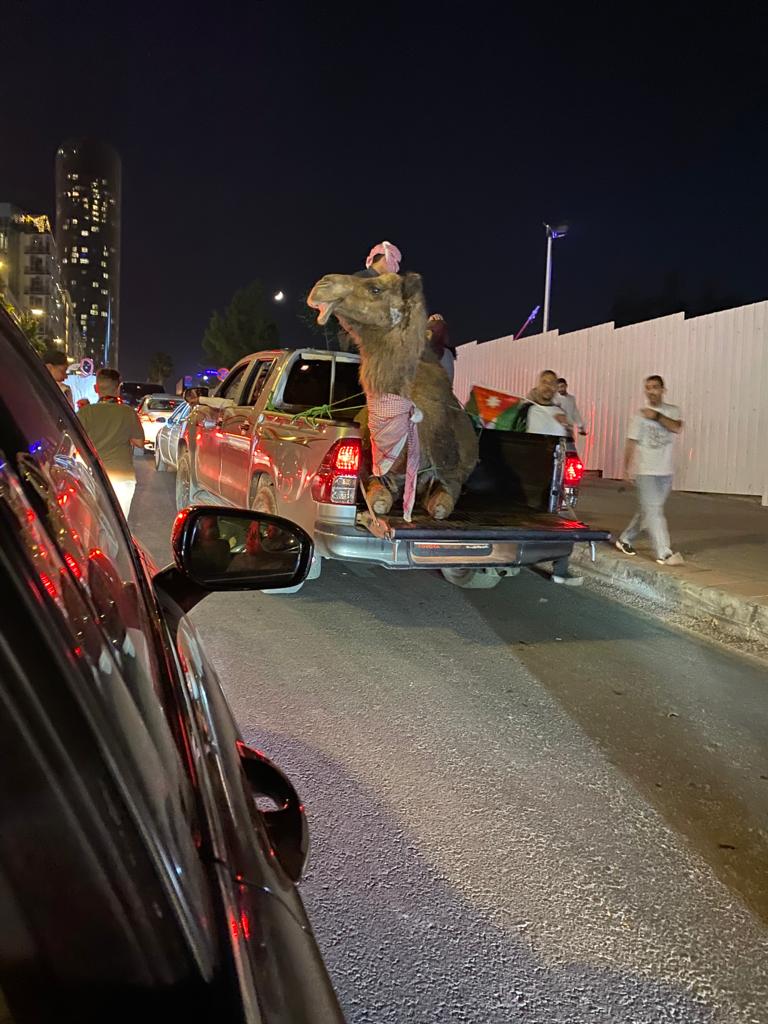
Camel on a pick-up!
I only recommend renting if you’re experienced and comfortable driving in foreign countries.
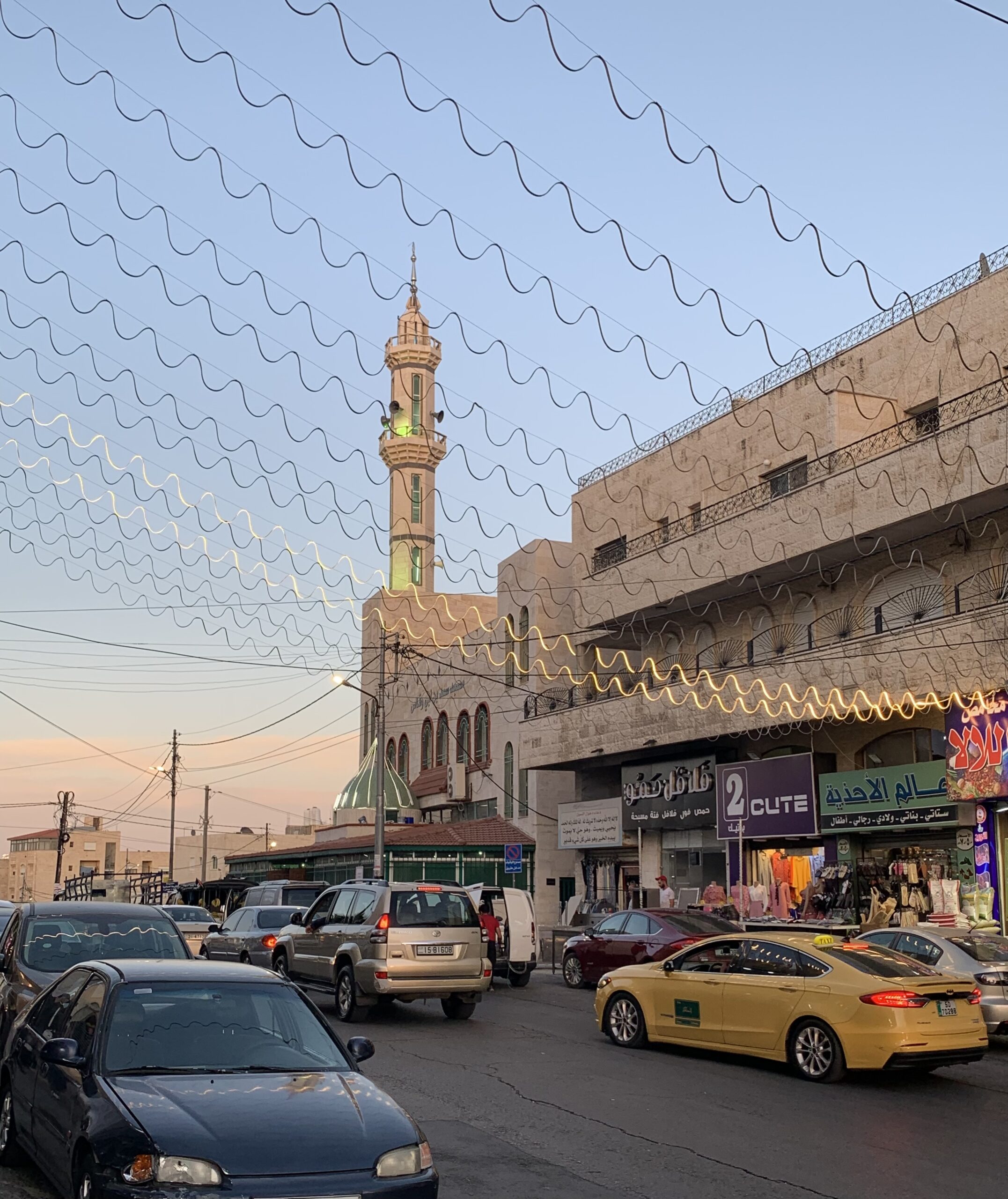
Yellow Taxis
There are plenty of yellow cabs to get you around the city. If it’s a short ride that comes up to less than 1 JOD, the driver will still charge you 1 JOD. It’s considered to be the minimum rate.
The good news is there are a plethora of rideshare apps in Amman. The main ones are Uber and Careem, widely used in the Middle East. There are other apps like Taxi F and Jeeny, but they may not be as reliable.
There are also buses, but locals mostly use them. Rideshare apps are affordable, and I used them when I visited Amman. Finally, you can always hire a driver for a day or two to take you to all the sites and places that interest you.
Things to Do in Amman, Jordan
Amman is recognizable for its dusty, beige buildings sprawled across its hilly city, but did you know that it has Greco-Roman ruins?
Step back in time to the Amman Citadel.
Head to the highest hill in Amman, Jabal El Qala’a. This hill is 850 meters above sea level and is within the old downtown or “El-Balad.” This is where you will find the Citadel, a 1700-meter wall.

Amman Citadel
This area dates back to the Bronze Age when this site was fortified. Over time, this area underwent several re-builds during the Iron Age, Roman, Byzantine and Umayyad eras.
The central feature of the Citadel is the remains of the Temple of Hercules. Two massive pillars, built during the Roman era, towering at 30 feet high. Another remanent is a stone-carved hand, believed to be the hand of the Roman statue of Hercules.
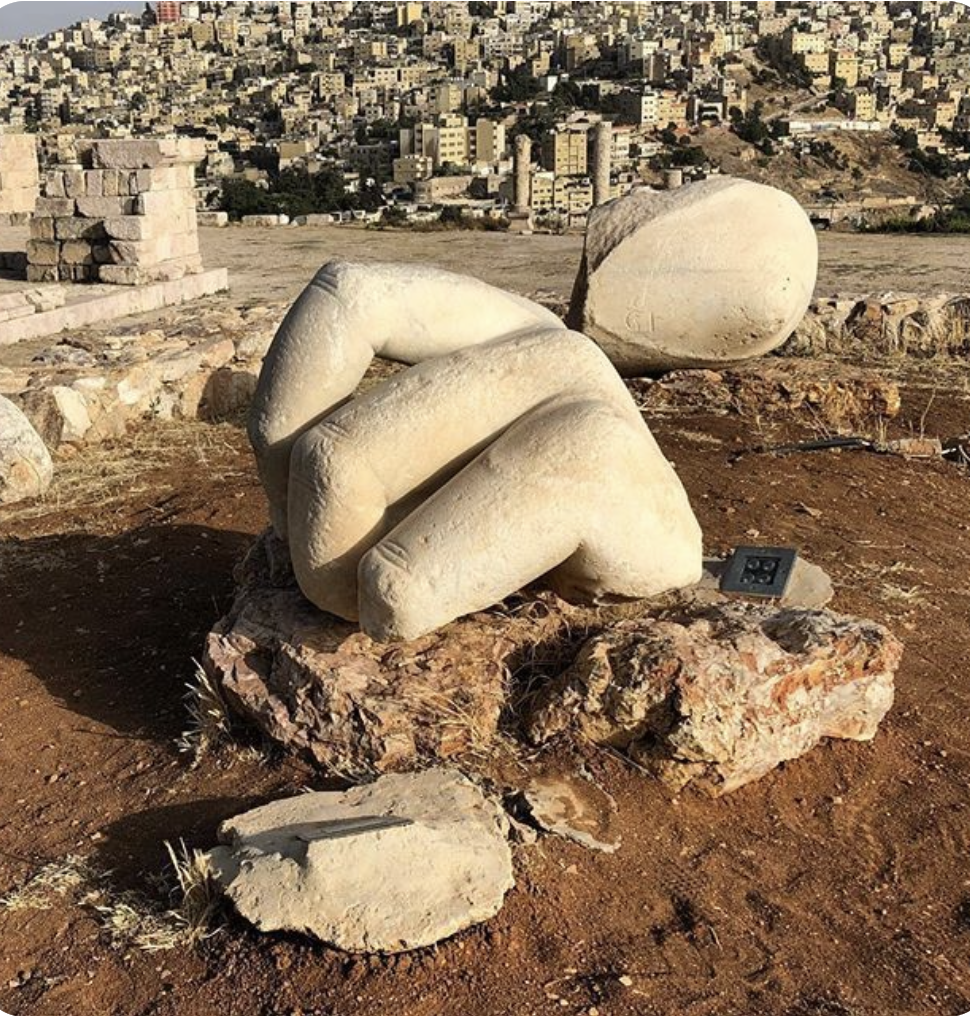
Hand of Hercules
The other central remaining structure is the Umayyad Palace, built around AD 720 by the Umayyad Arabs. This palace comprised an extensive complex of royal and residential buildings. Most of the court was destroyed around AD 749 by an earthquake. What’s left is the remnant of an audience hall that, in the past, was used to welcome visitors to the palace.
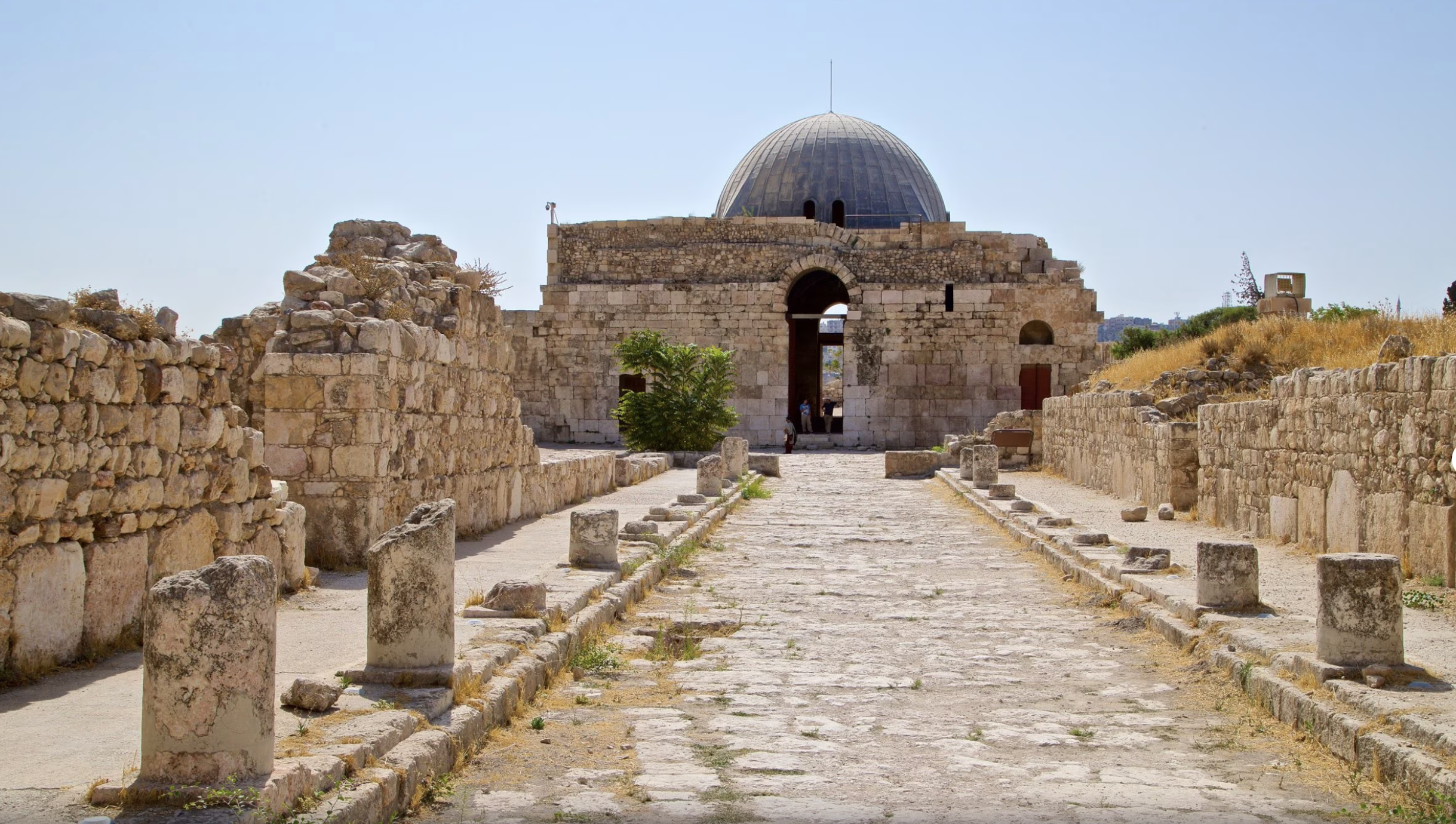
Ummayed Palace, Amman
Bonus: being on the highest hill in Amman affords you a great city view!
The entrance fee is 3 JOD at the time of this post.
Experience a Concert at the Roman Theatre
Not far from the Citadel is the impressive Roman Theatre cut into the side of a hill. It was believed to be built around the 2nd century by the Roman Emperor, Antoninus Pius.
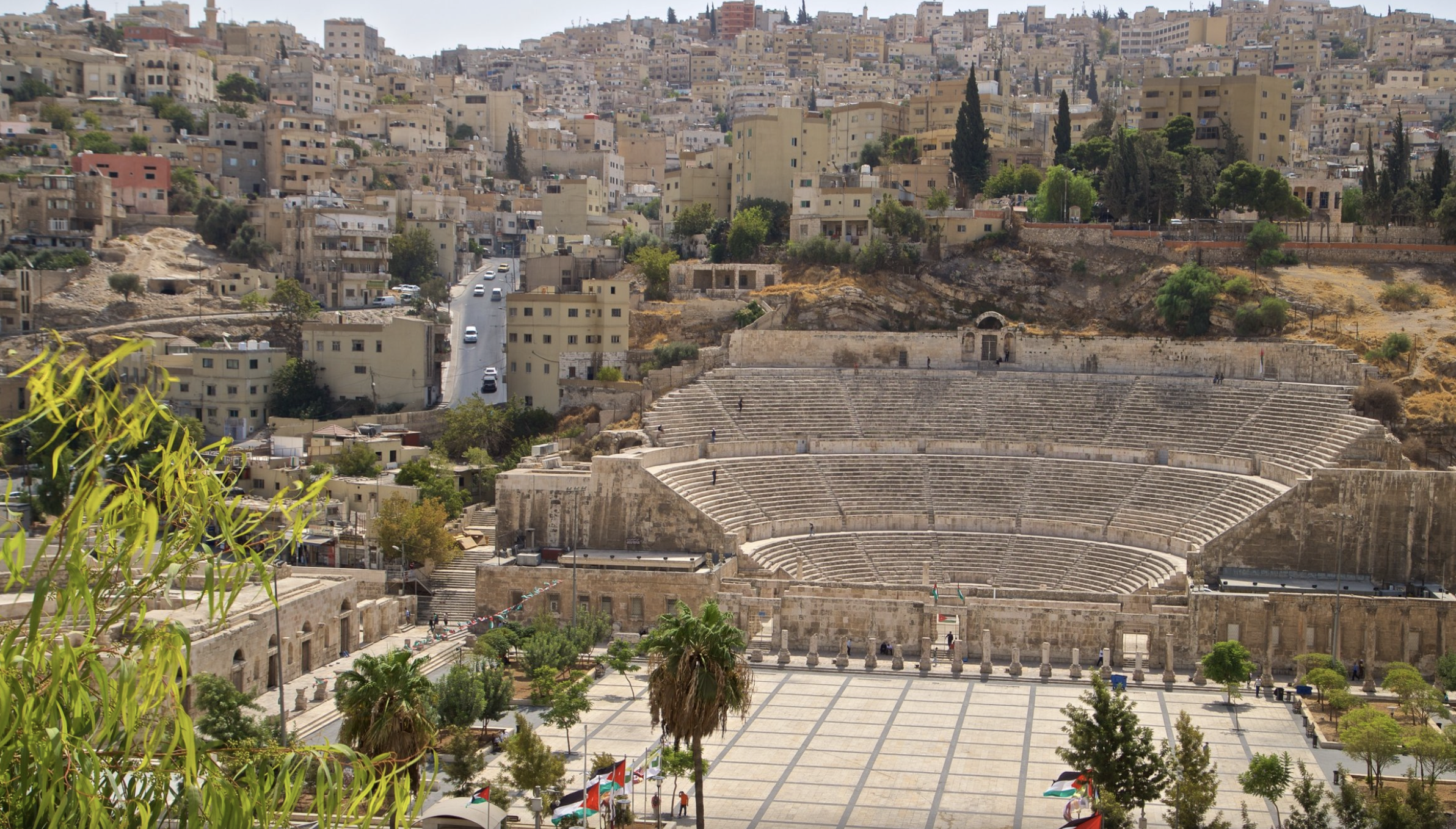
Amman – Roman Theatre
The Jordanian government started restoration efforts on the theatre in 1957. The theatre can seat up to 6,000 people. You can visit it on your own or as part of a tour.
If you’re visiting in the summer months, check if any cultural events or concerts are taking place during your visit that may pique your interest. The Romans knew a thing about acoustics; if you attend a show there, you can enjoy superior sounds!
The entrance fee is 2 JOD at the time of this post.
Visit the old Downtown.
After soaking up some history, explore the rest of the old downtown area of Amman. As the locals call it, El-Balad is filled with markets and shops where you can put your haggling skills to work.
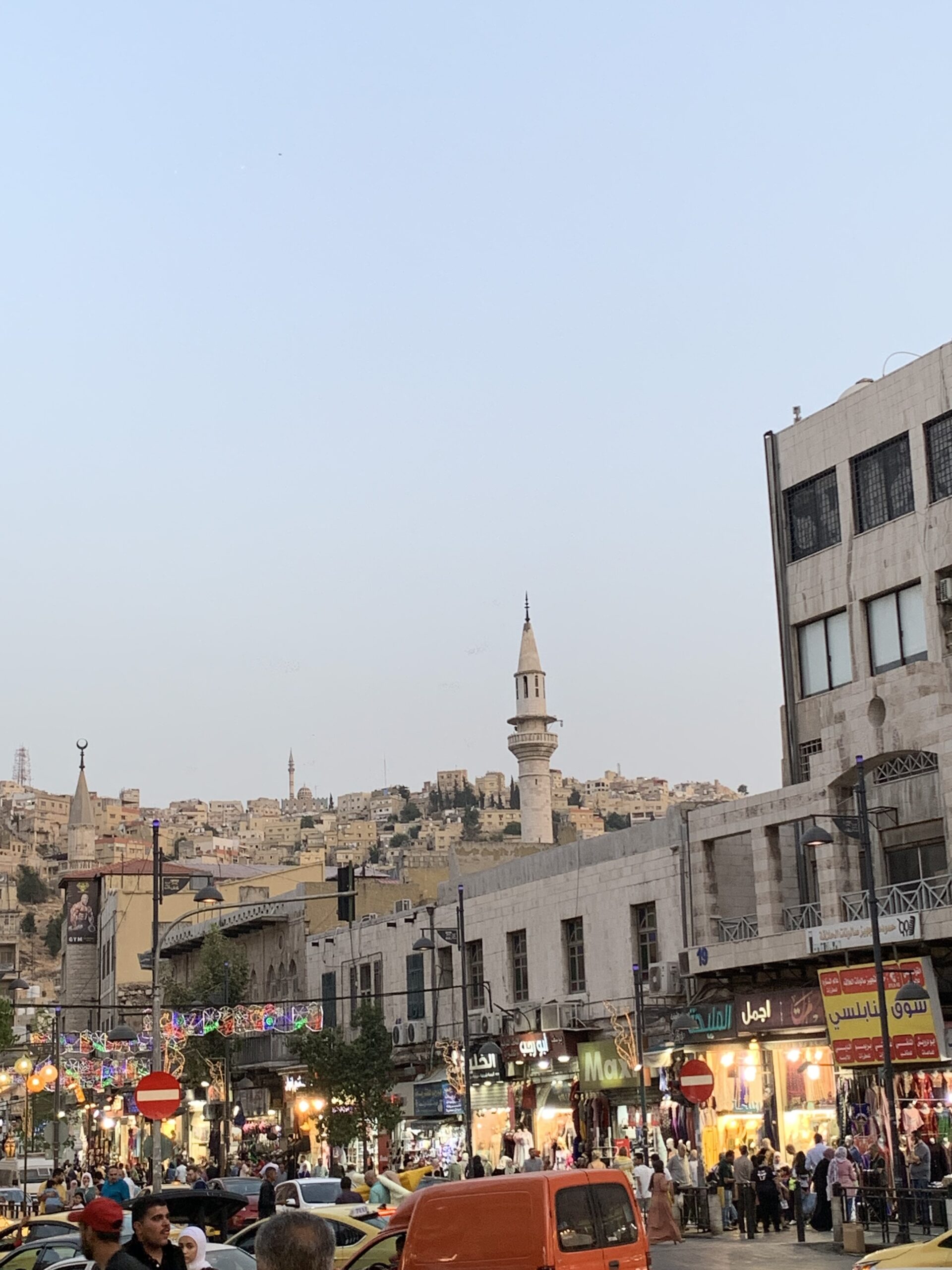
Downtown Amman
You can buy some souvenirs and other traditional trinkets. If you like gold, there is also a Gold Souk section with multiple shops selling primarily yellow gold jewelry.

Bling bling
You can’t leave downtown without making a stop at Habibah! They serve Knafeh, one of the best Arabic desserts in Amman.
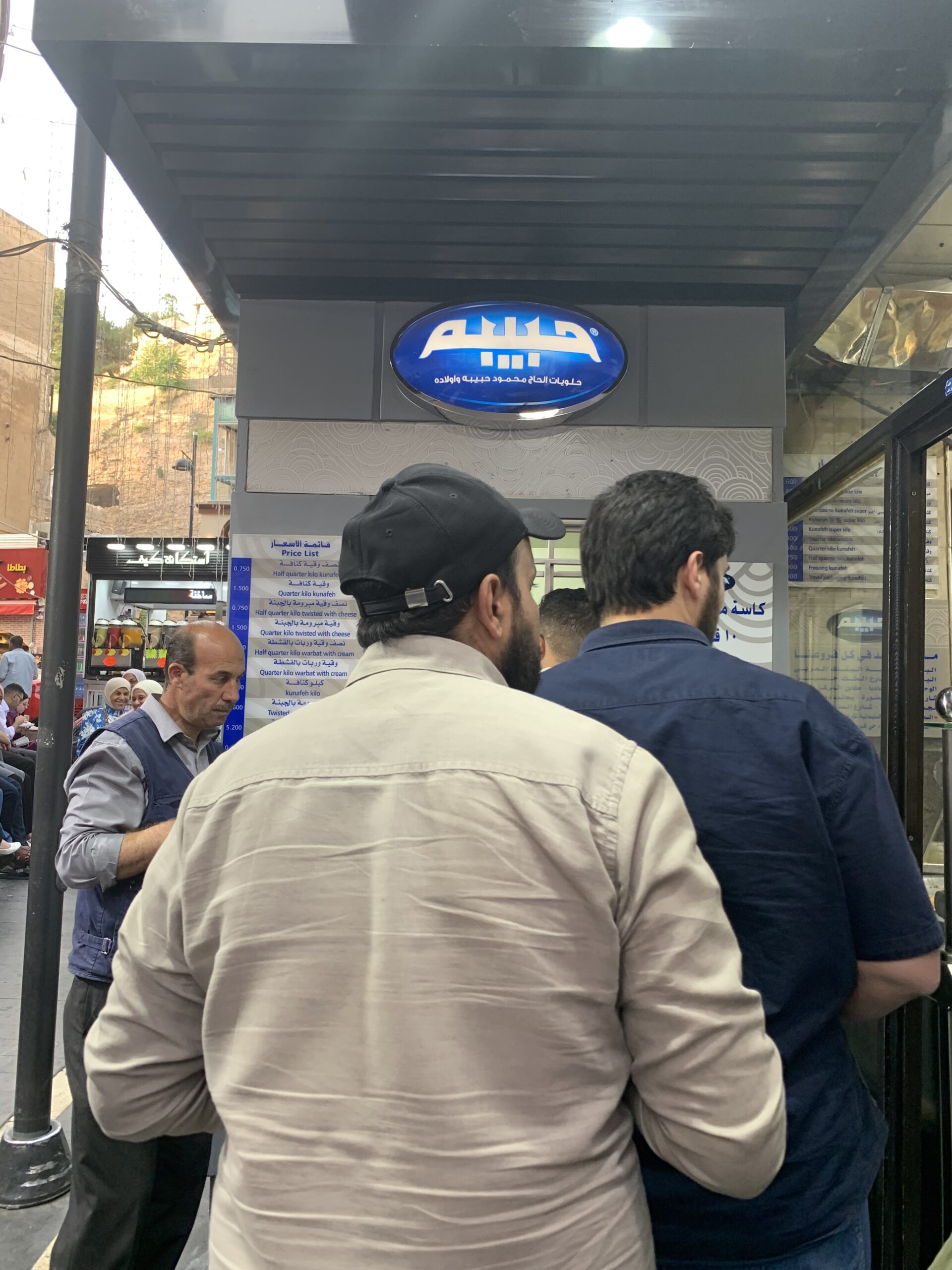
Habibah
They have two locations, and the one that I always go to is tucked in one of the alleyways and not on the main street. Just ask the friendly locals for directions, and they will help you. There’s always a lineup, but the line moves quickly and is so fresh!
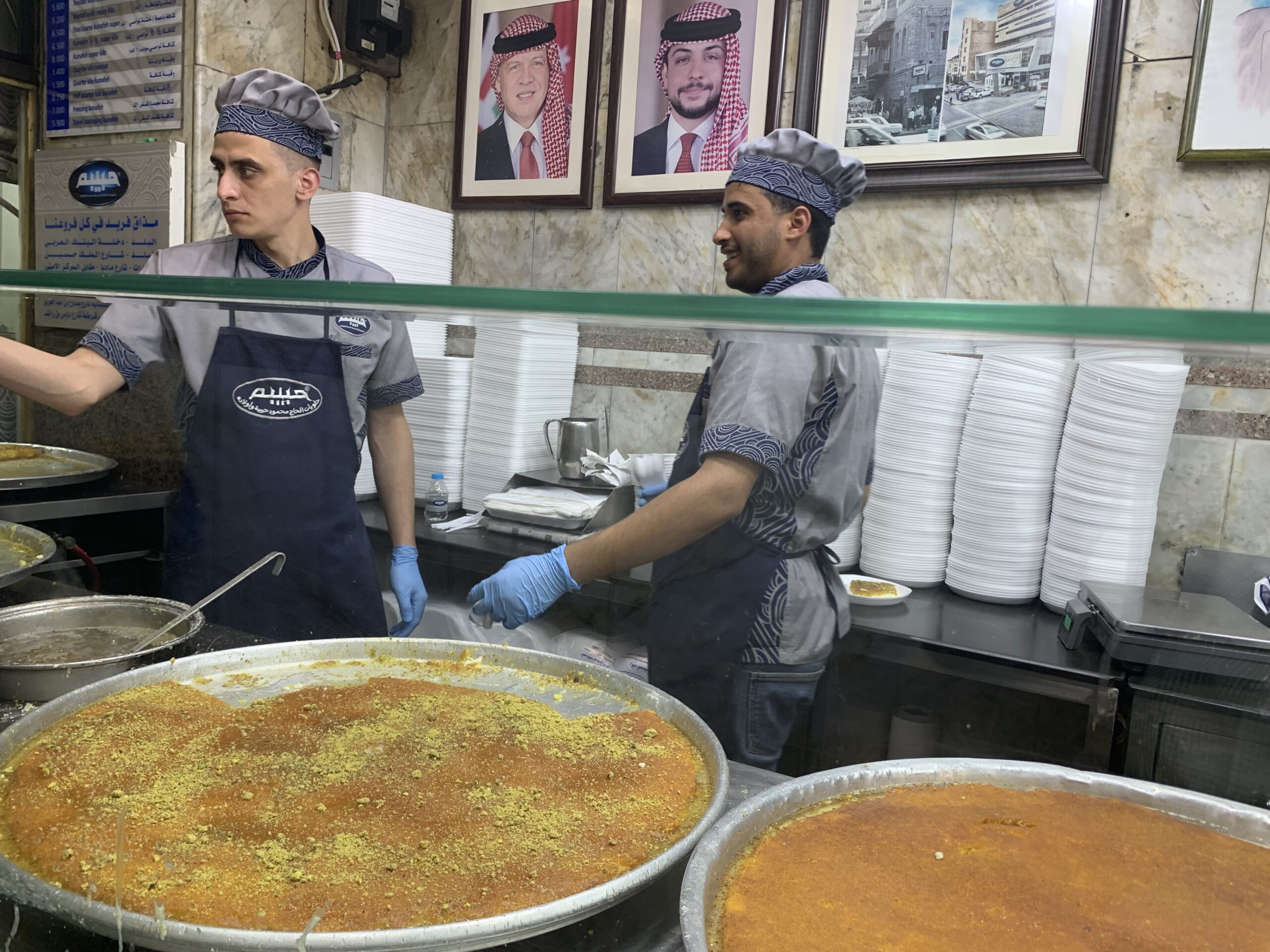
Habibah Knafeh
Knafeh’s origin is from the Palestinian city of Nablus. Today, you’ll find different versions throughout the Middle East, such as in Lebanon. It’s a sweet pastry made with Nabulsi cheese, drizzled with sugar syrup and sprinkled with pistachios. It would be a sin not to try it if you visit Amman!
Meander through Rainbow Street
One of the most incredible areas in Amman is Rainbow Street. It is situated on a hill called Jabal Amman. It’s packed with trendy shops, unique cafes, shisha lounges, pubs and restaurants that serve delicious food and have a fun vibe.
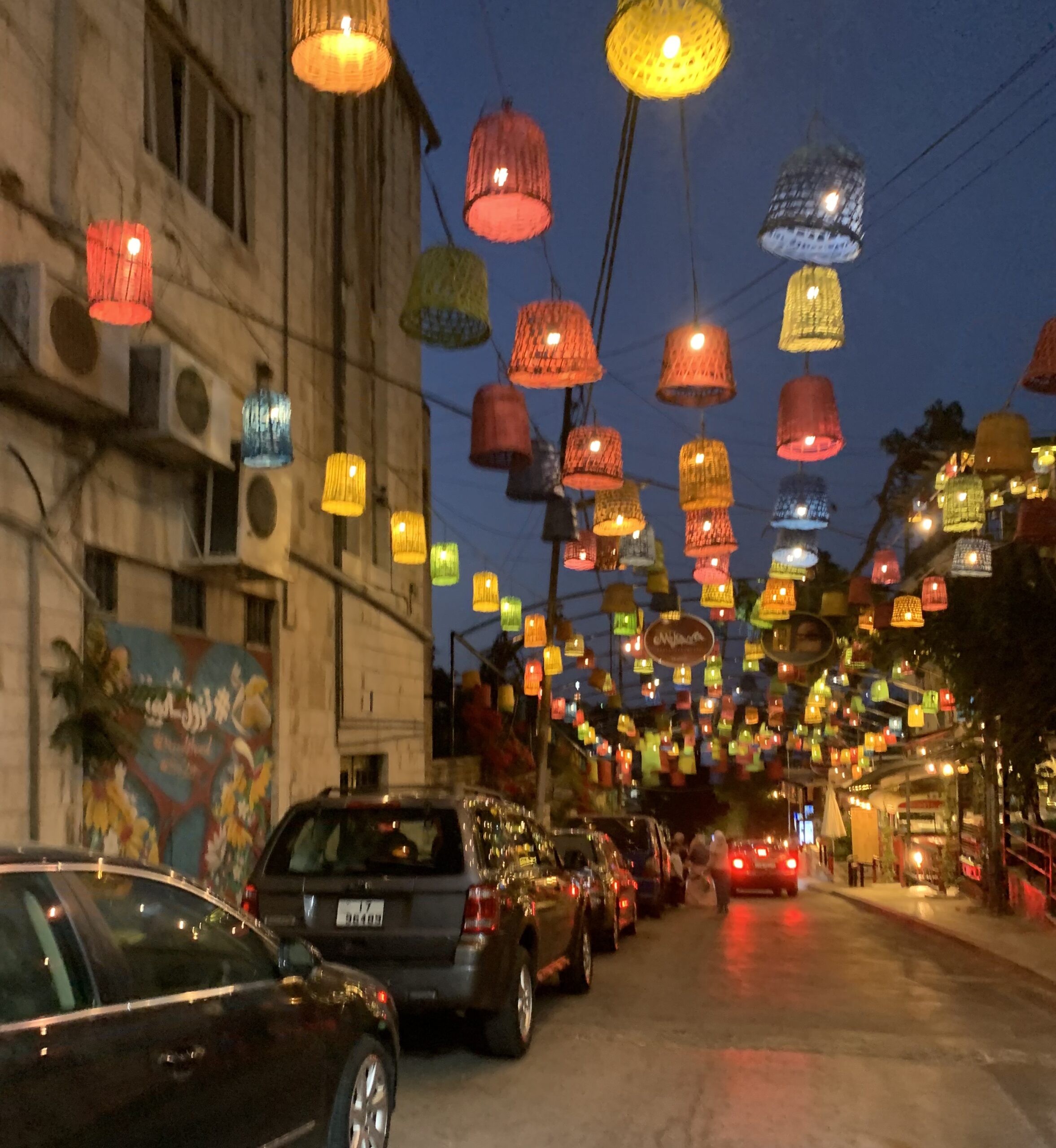
Rainbow Street, Amman
If you visit in the morning, you can have a hearty breakfast at one of the restaurants there. If you prefer a quick bite, see the hole in the wall, Al Quds. It’s trendy for its delicious falafel sandwiches served in a baguette. It’s also one of the cheapest meals you can have in Amman!
Another great place for eats is Mijana. They serve a mix of Levantine and Western dishes. I went there for dinner and savoured the food there, along with my mint lemonade.
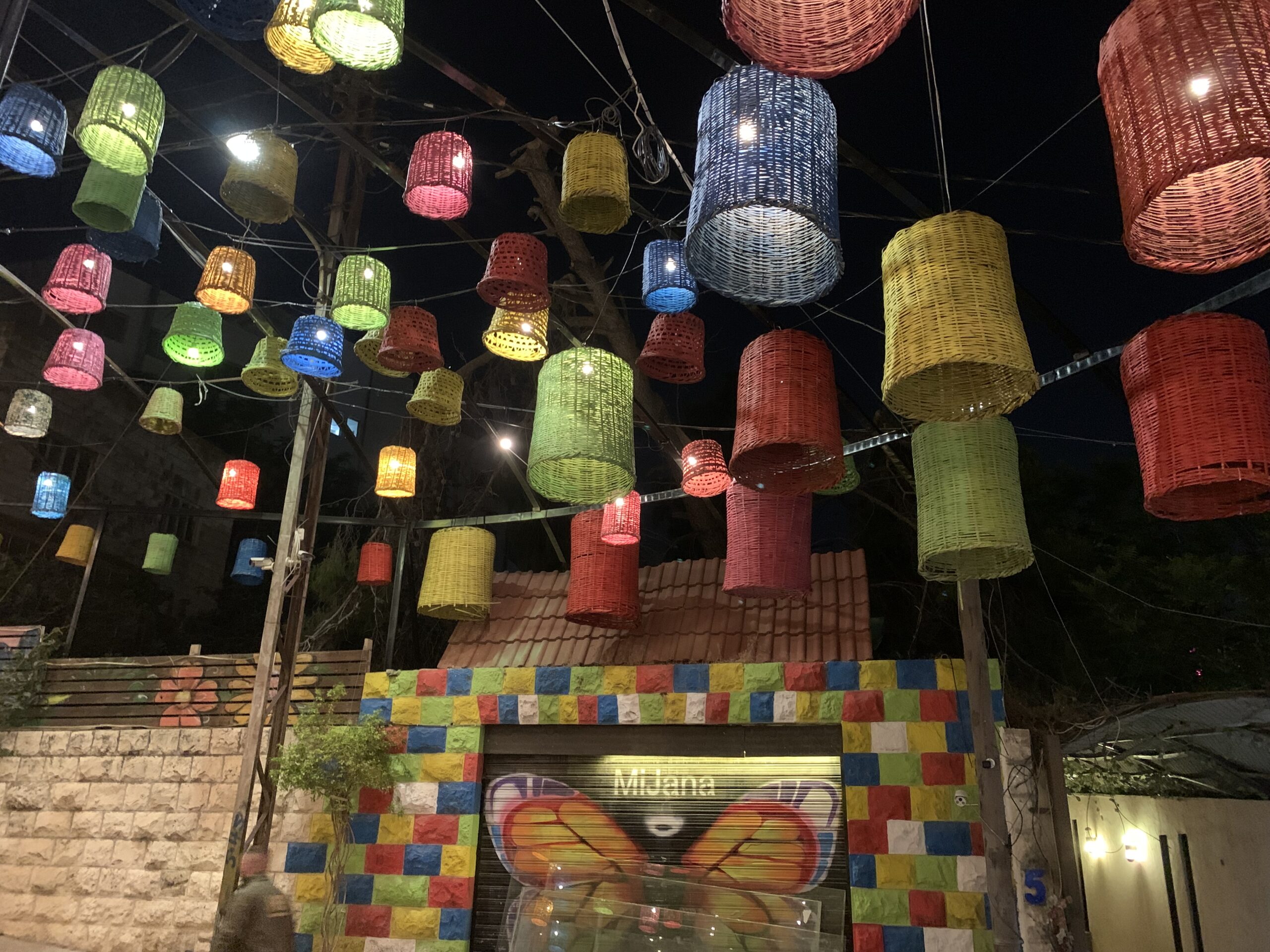
MiJana, Rainbow Street

Mint freshness in a glass
They have indoor and outdoor seating and sometimes have a musician performing.
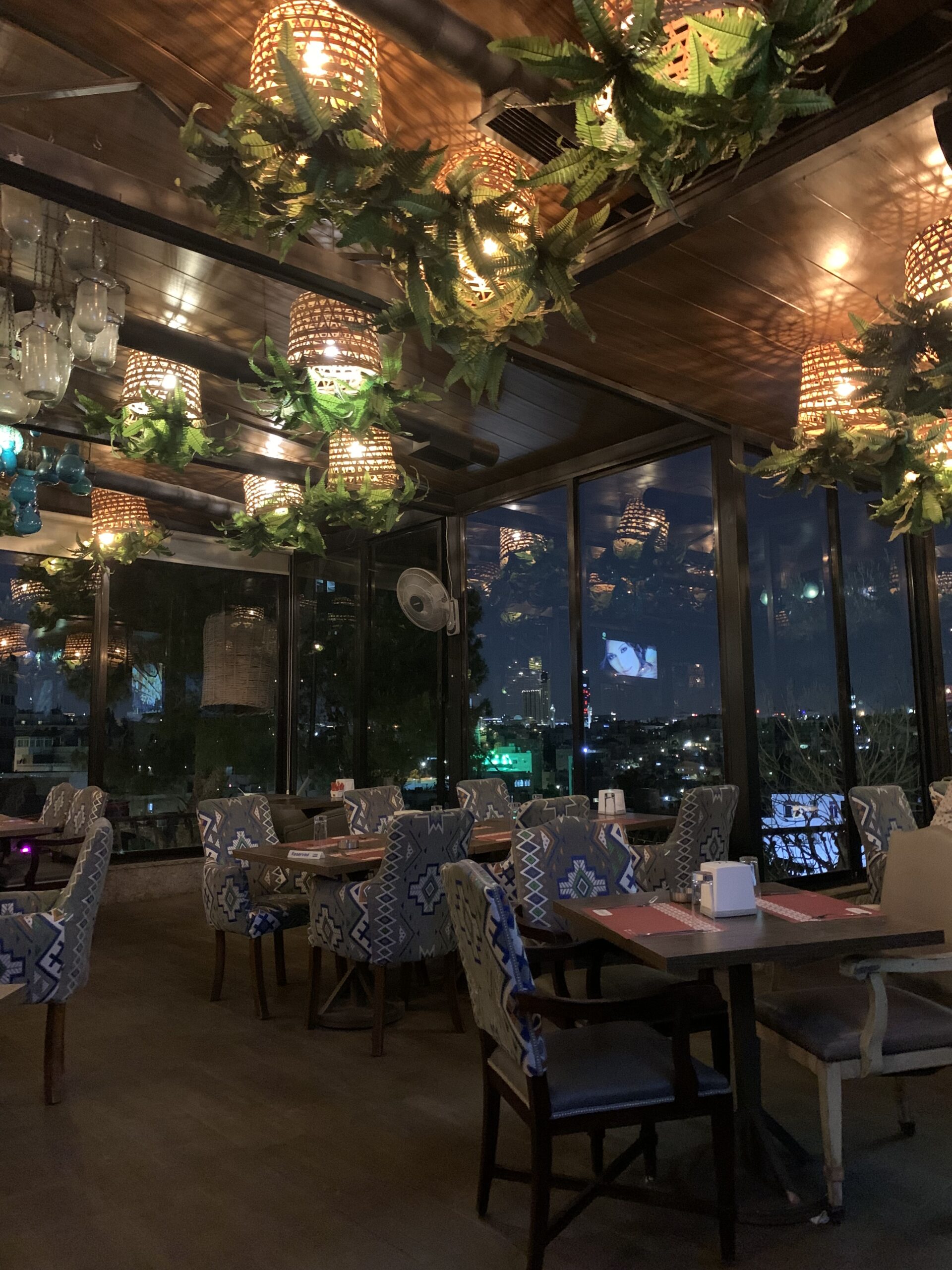
MiJana, Rainbow Street
After eating your way through Rainbow Street, you can visit the shops, buy some souvenirs and take in the lovely views that overlook other neighbourhoods in Amman.
If you’re visiting between mid-May and mid-September, I highly recommend going to Rainbow Street on a Friday. It’s the one day in the week where you’ll find a market open called Souk Jara from 10 a.m. to around 10 p.m. You can shop for hand-made crafts, antiques, art and clothes. They also have stands for food, such as spices, nuts and fruits, but they’re a bit overpriced!
Popular Day Trips from Amman, Jordan
After exploring the capital, you can use it as a base for popular day trips. Here are a few of the best ones (this is not an exhaustive list!):
The Dead Sea:
Less than an hour’s drive from Amman, head to the lowest point on earth – the Dead Sea! You can’t swim in it, but you can float on this very salty water. A must thing to do is to cover your body with the Dead Sea mineral mud. Trust me, It’s a great natural exfoliant for your skin!
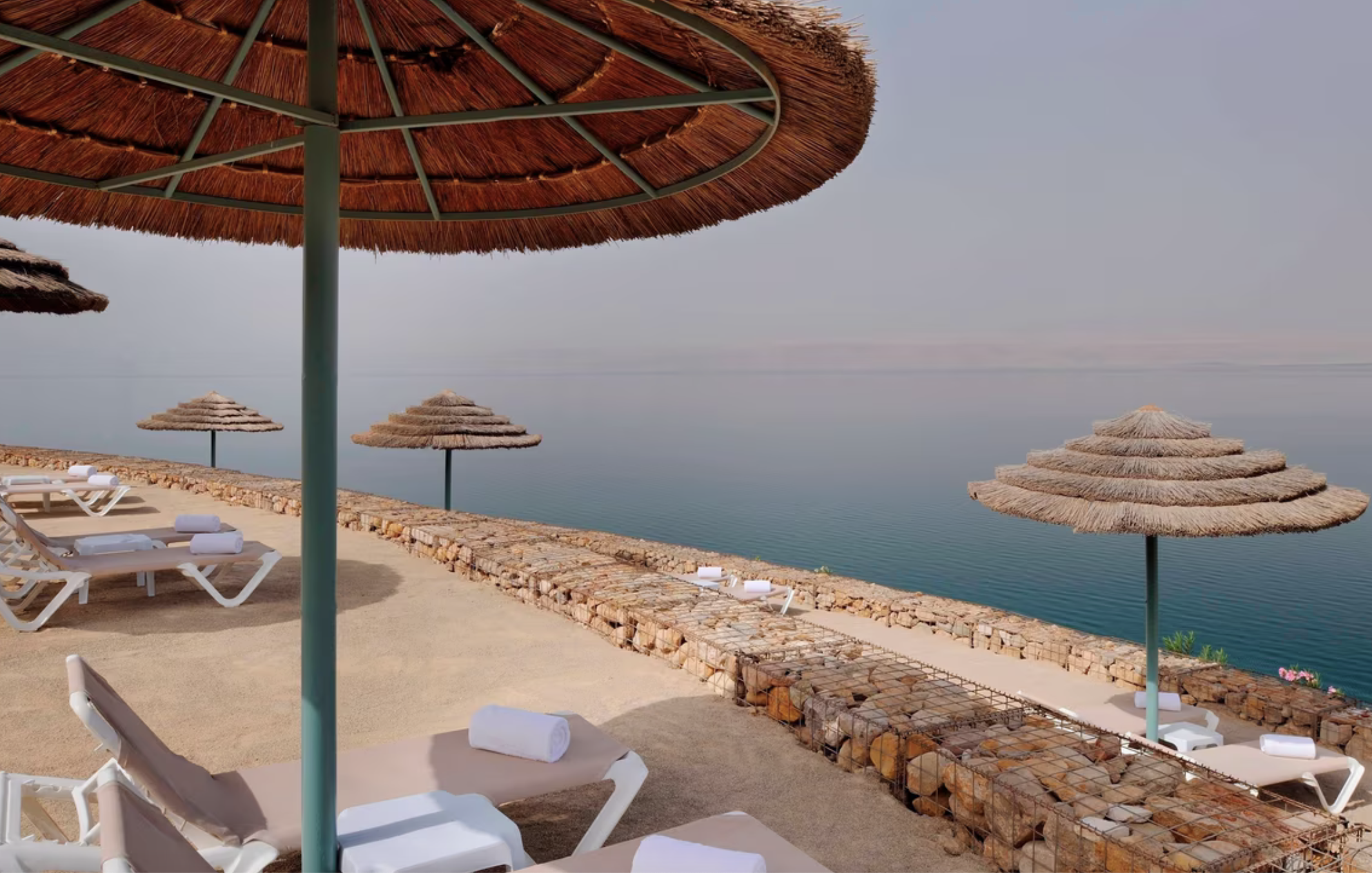
Image Credit: Marriott Dead Sea
There aren’t that many activities available at the Dead Sea. But, if you’re looking for relaxation and indulging in spa treatments, plenty of resorts are on-site to spend the night there.
Tip: Don’t shave just before you go. If you have any cuts, you’ll feel the sting when you’re in the water!
Madaba and Mount Nebo:
Madaba
The quaint city of Madaba is South of Amman and about half an hour’s drive from there. It’s also referred to as the City of Mosaics. This is due to the Byzantine and Umayyad mosaics that adorn many buildings there.
One of the top highlights of Madaba is the Saint George Church. It’s famous because of what’s inside it! When you walk into this Greek Orthodox Church, on the floor, you’ll find the most extensive mosaic map in the world. It is also the oldest map of historic Palestine and the Nile Delta. This is why this Church is called the Church of the Map.
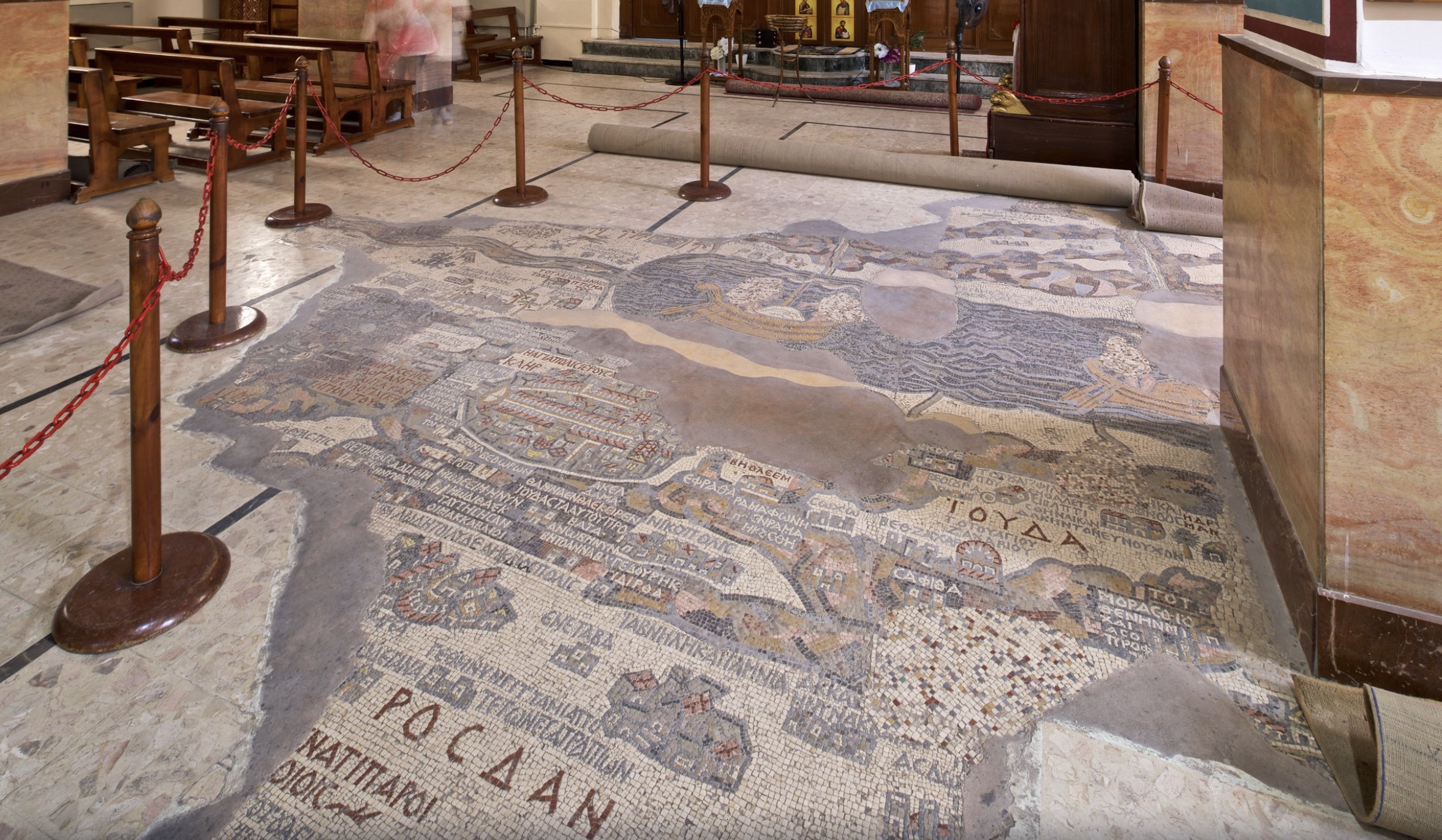
Church of the Map – Madaba, Jordan
Not far from this Church are an archeological park and a museum, which include the Church of the Virgin Mary and the Hippolytus Hall.
Mount Nebo
You can pair your visit to Madaba with Mount Nebo since they’re only 10 kilometres apart. Mount Nebo holds religious significance to Christians, as mentioned in the Bible. At the top of the mountain, you’ll find a serpentine cross sculpture called the Brazen Serpent.
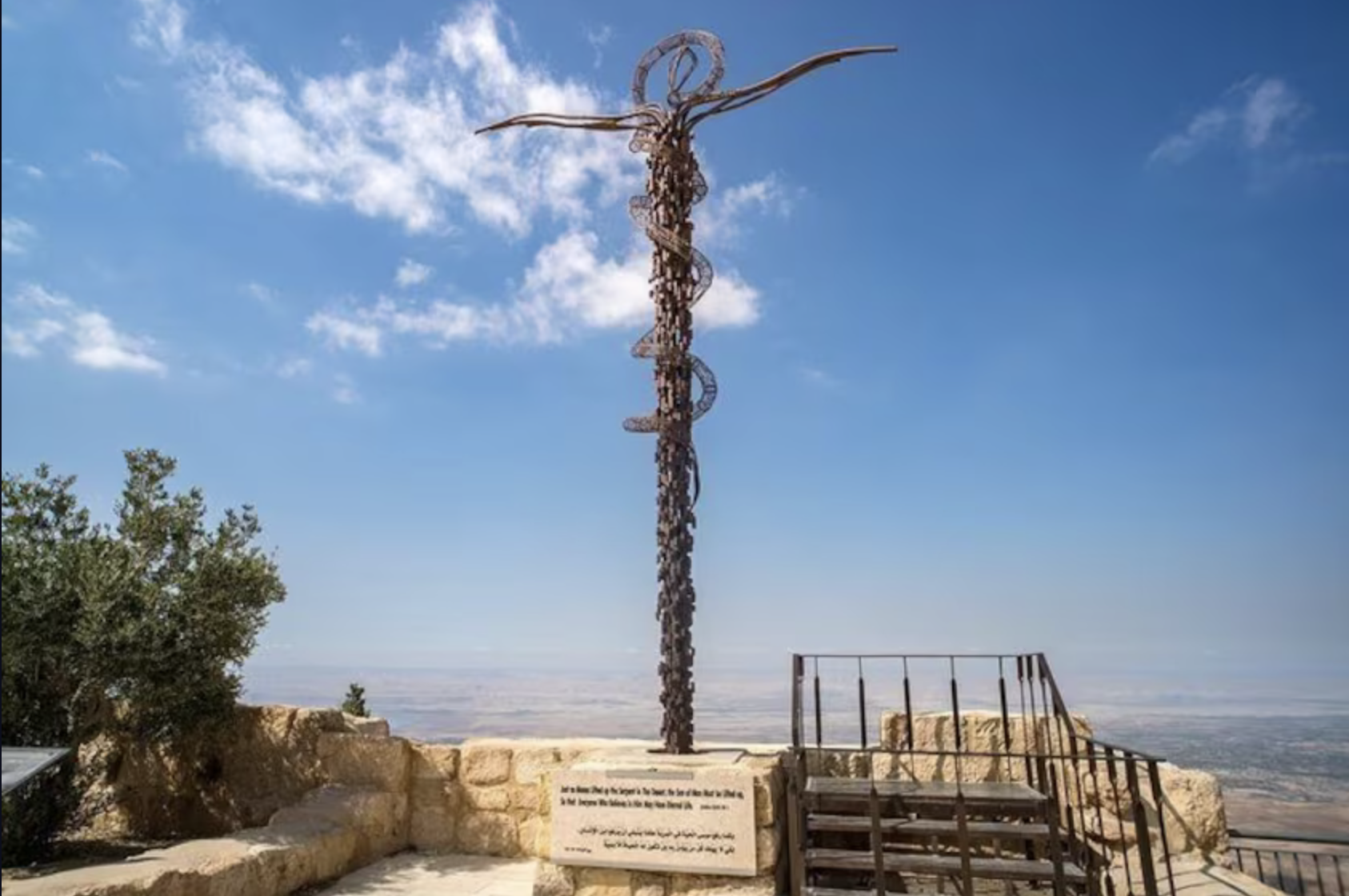
Brazen Serpent
Also on top of the hill is a church with well-preserved Byzantine mosaics inside. With the mountain standing 815 metres above sea level, you can enjoy spectacular views overlooking the Jordan River, Bethlehem and Jerusalem on a clear day.
Jerash:
About 45 minutes north of Amman, you’ll find the ancient city of Jerash (Ǧaraš in Greek). It’s one of the largest and most well-preserved Greek and Roman architecture sites outside of Italy. This massive site includes an Archeological museum, Roman theatre, Hadrian’s Arch, Hippodrome (Roman arena), Colonnaded Street, Nymphaeum (ornate fountain) and more!
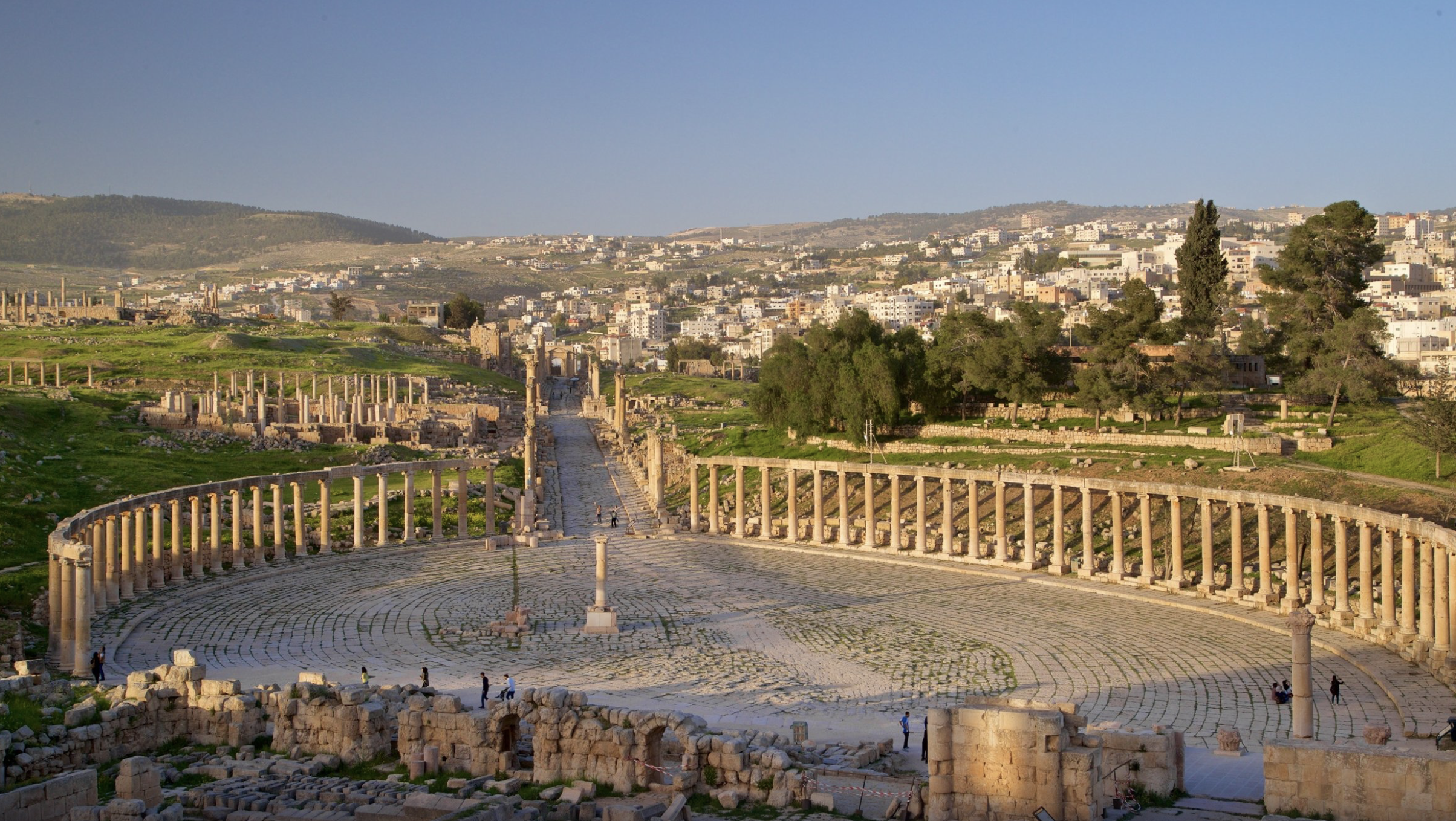
Oval Forum – Jerash, Jordan
If you want to save money, take a bus or hire a taxi to take you to Jerash and back to Amman. Once you arrive at Jerash, you must pay the entrance fee of 10 JOD. This includes entrance into the museum.
At the entrance of Jerash, you can hire a tour guide. It should be cheaper than going with a guided tour from Amman unless you combine it with another one.
Where to Stay in Amman, Jordan
All the major hotel brands have a presence in Amman, with several luxury options. Marriott has the most significant footprint here, where you’ll find a St. Regis, Ritz-Carleton, W Amman, Sheraton and a Marriot. The oldest luxury hotel in Amman is the Four Seasons, which was renovated a few years ago.
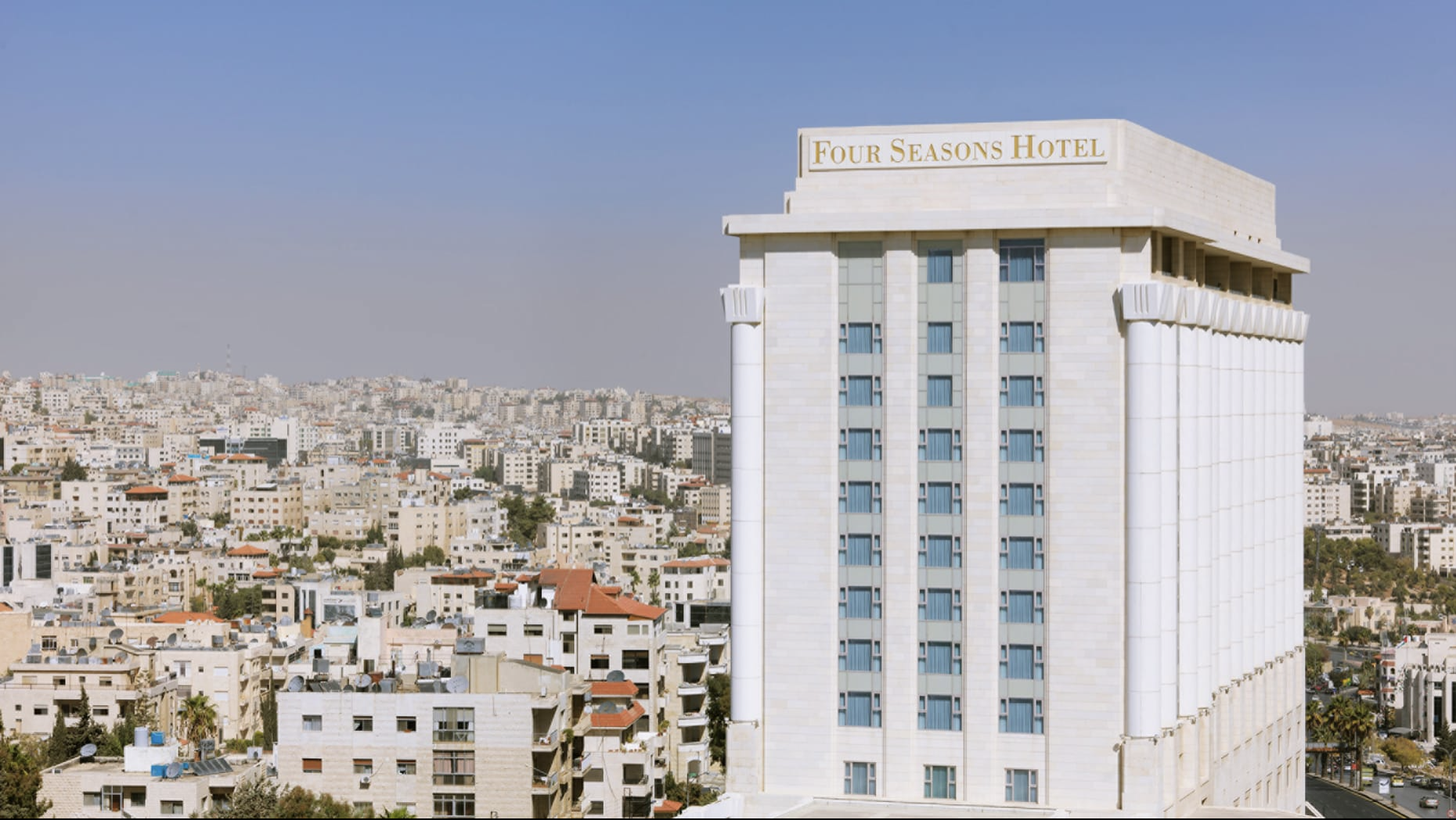
Four Seasons Amman
There is also a Fairmont, Grand Hyatt, Kempinski, Hilton and InterContinental. Most of these hotels are concentrated in the 5th circle, near the affluent neighbourhood of Abdoun. If you want the most central location, the W Amman is the one to go for, and it’s where I stayed. It’s located in the Al-Abdali neighbourhood, which is considered to be Amman’s new downtown.
Tips & Things to Know – Amman, Jordan
Here are a few things to know about Amman and some tips!
Visa
As a Canadian, you must pay 40 JOD for a single-entry visa upon arrival. Note that even though they have a machine that accepts Visa/Mastercard, it wasn’t working when I visited. To be safe, make sure you have Jordanian dinars with you. Otherwise, you’ll have to use an ATM or a currency exchange at the airport, giving you an unfavourable rate.
Jordan Pass
If you plan on visiting many of the famous tourist sites in Jordan, notably the UNESCO World Heritage Site of Petra, then buying a Jordan Pass ahead of your trip is worthwhile. If you stay in Jordan for at least three or more days, this pass will waive the Visa entrance fee.
This pass includes entry to 40 attractions/sites, such as Jerash, Wadi Rum, Amman Citadel, etc. The Jordan Pass costs range from 70 to 80 JDs, depending on how many days you plan to spend exploring Petra.
Currency and Payments
The Canadian dollar does not go very far here. The Jordanian dinar is strong and is pegged to the USD. You need 200 CAD to make 100 JOD. Hence, you have to double up!
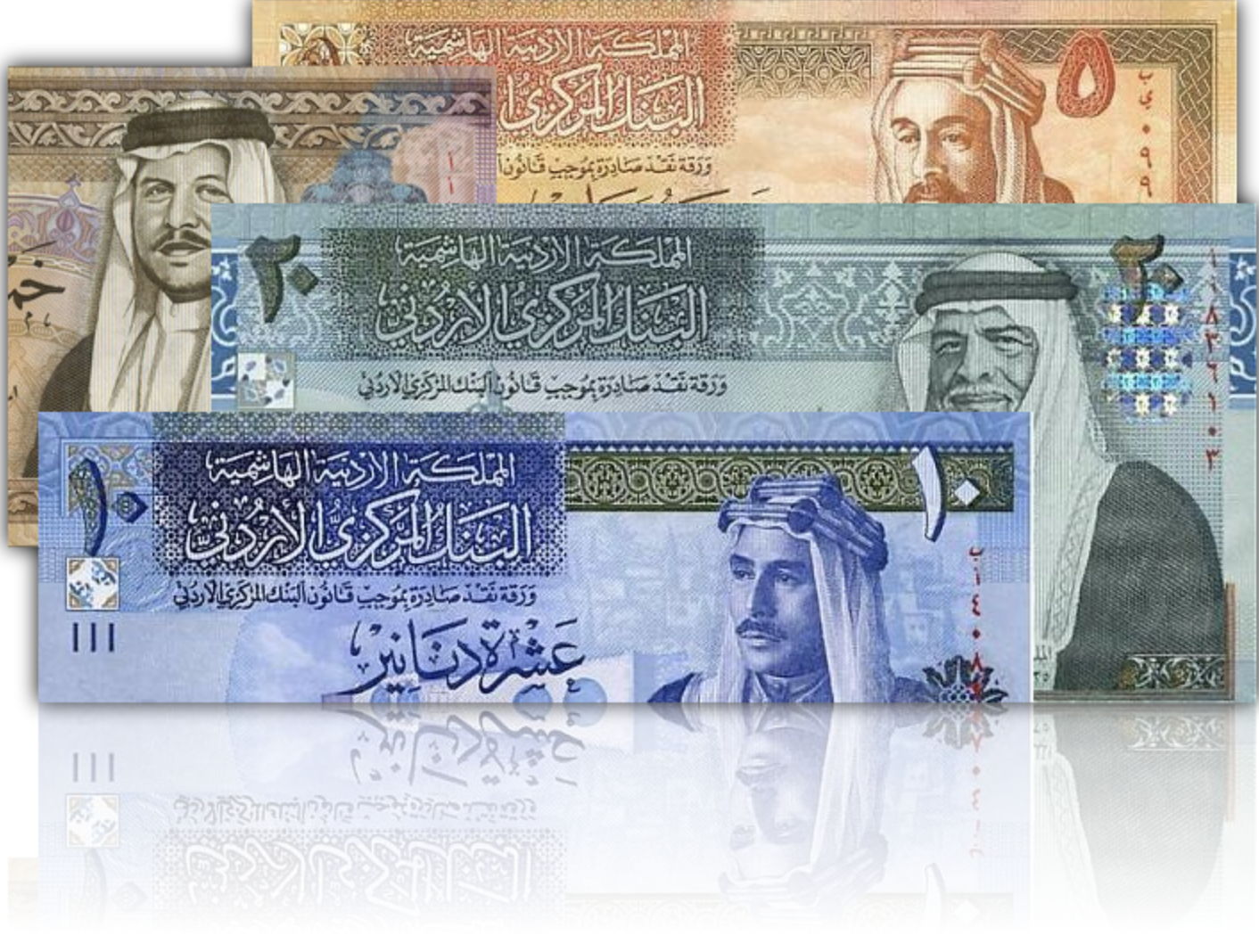
Jordanian Dinar
Visa and Mastercard are widely accepted at restaurants, cafes, shopping centres and hotels. Some places accept American Express, but it’s more limited. If shopping in a souk (market), having cash on hand is best.
Language
Arabic is the official language spoken in Jordan, with English being the second. English is taught as a second language in public schools. For the wealthy, they attend American or British private schools that operate in English. It would help if you didn’t encounter communication issues there since most locals have a working knowledge of English, and some are fluent.
Food
Traditional Dish
For me, Amman is synonymous with food. The national dish in Jordan is called Mansaf. It’s a hearty dish made of pieces of lamb on a bed of yellow basmati rice, including bread soaked in yogurt sauce made from jameed (dried yogurt). Some of the traditional restaurants serve it, such as Jabri.
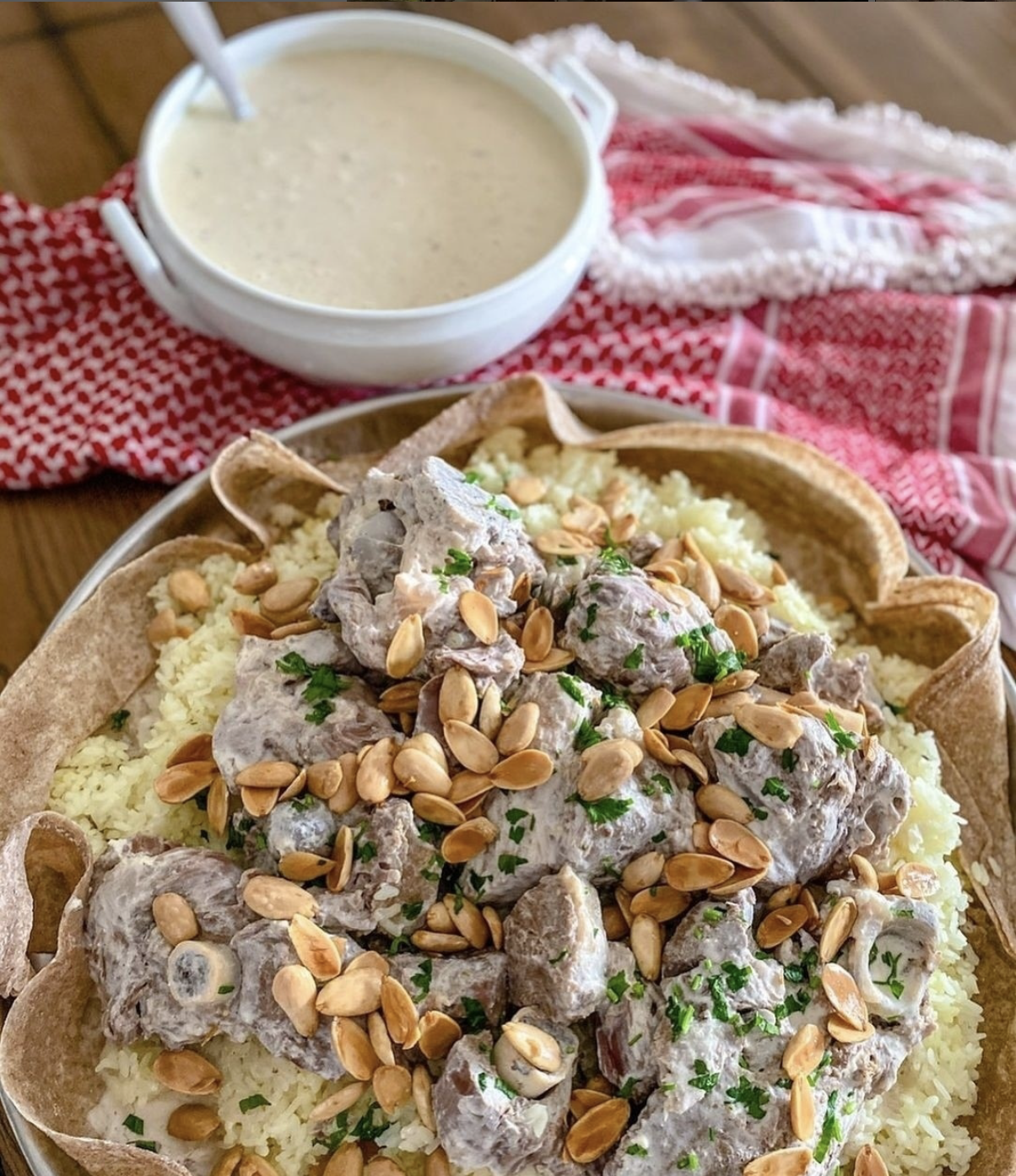
Image credit: @bailasanbites – Mansaf Perfection
Shawarma
For the best beef shawarma in Amman, I recommend going to Reem. Make sure to go to their original location on the 2nd Circle in Jabal Amman. Shawarma 3a Saj is an excellent option if you prefer chicken shawarma.
Manakeesh
If you like meat, cheese or thyme pies (known as manakeesh in Arabic), I highly recommend going to Blue Fig in the Abdoun neighbourhood. They also serve sandwiches, salads and other dishes. I’ve been to it numerous times whenever I’m in Amman. It’s an excellent spot for breakfast and lunch.
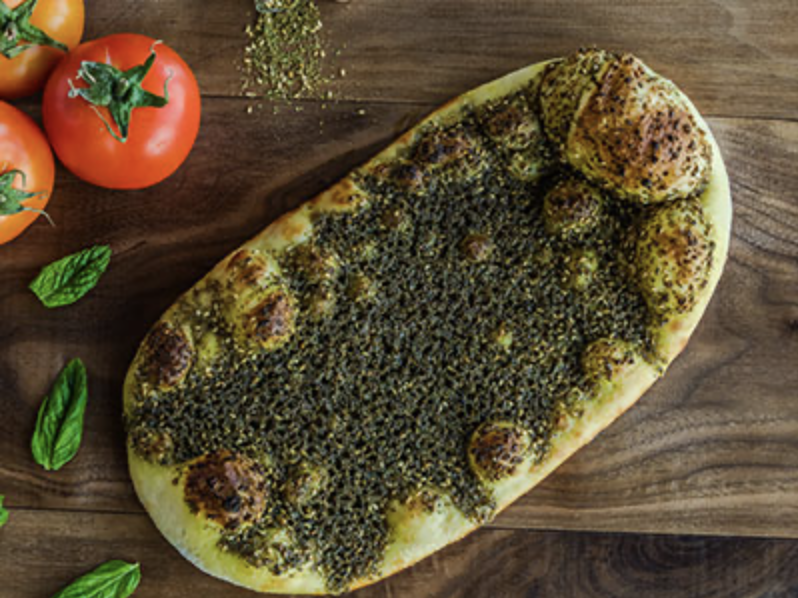
Blue Fig – Thyme Manaqeesh
Fine Dining
The top fine dining restaurant in Amman is Fakhr El-Din, a Lebanese restaurant serving the best Levantine food. Its menu includes the famous mezze, the Middle Eastern version of tapas made of small plates like hummus, baba ghanoush, muhammara, and many more. They also serve delectable grilled meats.
Make sure to make a reso in advance – it’s trendy! If it’s fully booked, a decent alternative is Karam Beirut, which I did when I was in Amman.
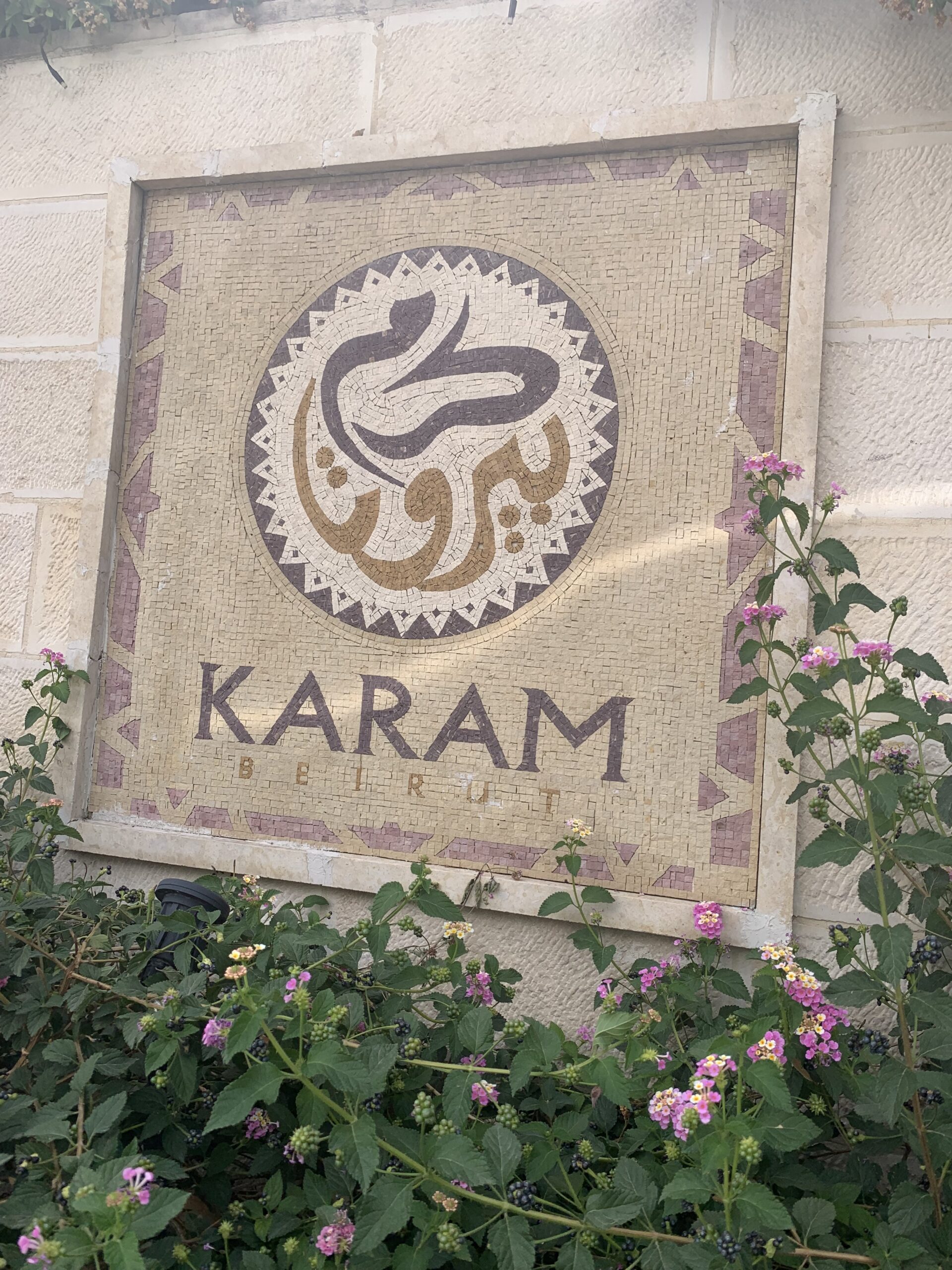
Karam Beirut
Conclusion
Most tourists that touchdown in Amman make a beeline to the UNESCO World Heritage Site of Petra, among other sites outside the capital. I hope this guide gave you a flavour of this beautiful city and the heart of Jordan. Since a trip to Jordan will have you landing and likely departing from Amman, don’t miss the opportunity to spend a couple of days or more exploring this vibrant city and its nearby surroundings!

Amman, Jordan
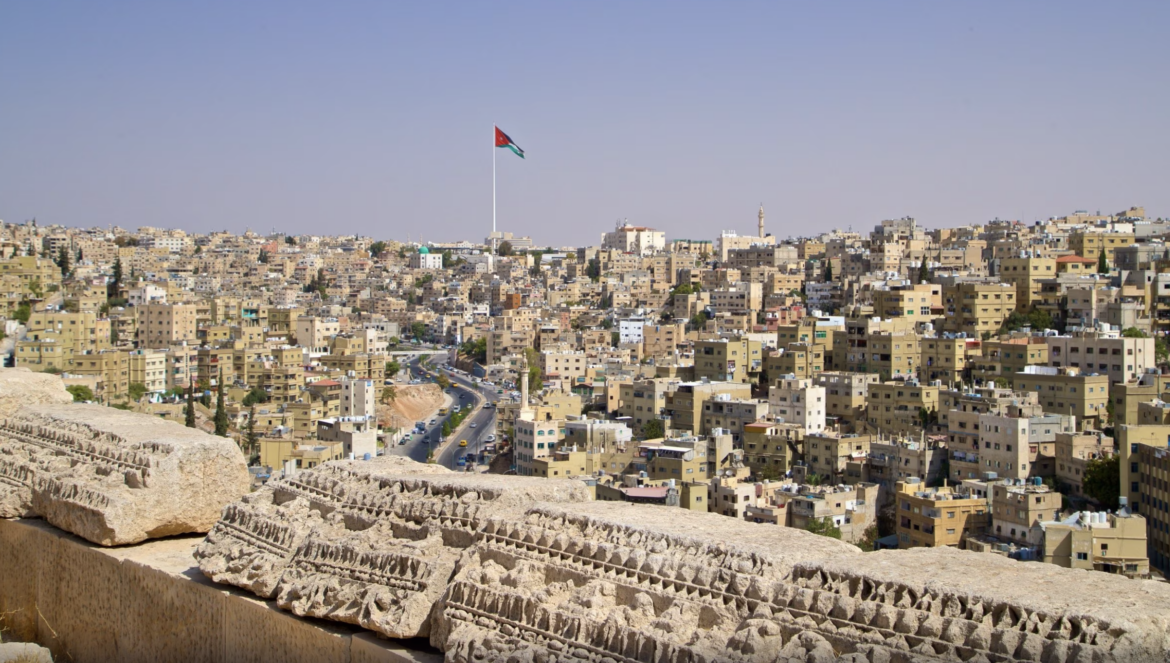
10 comments
Very interesting. Great job. It contains a lot of information about the city of Amman, which is very useful for anyone who is planning to visit Amman.
Thanks for the kind words 🙂
Great read, very descriptive and lots of great tips, thank you!
Thank you for taking the time to read it 🙂
What a great overview. I really appreciate this format with insights to day trips and other tips
Thank you! I’m glad you found it helpful.
Good write up. Spent a couple hours in Amman on the way from Jerash to Petra and liked the look and vibe of the town quite a bit. Plan to go back next Fall, so I appreciate the tips.
Thanks MFK! Amman definitely has a lot to offer. Hope you enjoy your next trip there!
We spent a very quick day in Amman and wish we had had more time there. The Call to Prayer heard from the Citadel was so beautiful as it echoed through the valleys. Knafeh was delicious. Amman felt very safe and welcoming, I want to visit again soon.
Happy to hear you enjoyed your time in Amman, even if brief! Hope you have the opportunity to visit again. I also always look forward to the Call to prayer 🙂